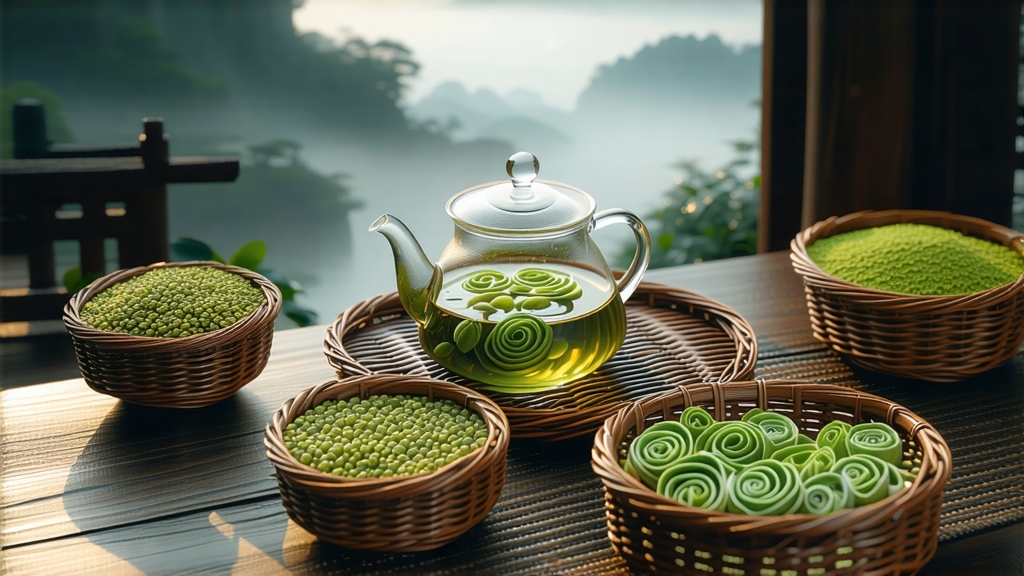
Among the pantheon of Chinese green teas, few names evoke as much romance and sensory anticipation as Biluochun. Literally “Green Snail Spring,” the tea is prized for its tiny, tightly rolled spirals that resemble miniature snails and for the intoxicating aroma that once filled the private chambers of Qing-dynasty emperors. To international drinkers accustomed to the vegetal simplicity of Japanese sencha or the nutty depth of gunpowder, Biluochun offers a revelation: a cup that is simultaneously floral, fruity, and marine, as if someone distilled the breeze of an April orchard into liquid form.
Historical records trace Biluochun’s birth to the Dongting mountain range of Jiangsu province, a landscape of terraced tea gardens wedged between the vastness of Lake Tai and the fertile plains of the Yangtze River Delta. According to local chronicles written in 1699, a tea picker named A-Xiu accidentally placed newly plucked leaves into the front of her apron while climbing the rocky slopes. The warmth of her body prompted an unexpected enzymatic change, releasing an extraordinary fragrance that attracted the attention of a passing monk. He brewed the leaves, found the liquor astonishingly fragrant, and christened the tea “Xia Sha Ren Xiang”—“Scary Fragrance”—because its perfume was almost too intense. The Kangxi Emperor later sampled it during his southern inspection tour, judged the name inelegant, and rechristened it Biluochun to honor its shape and harvest season.
The terroir of Dongting is inseparable from the tea’s identity. Two peaks, Dongshan (East Mountain) and Xishan (West Mountain), rise from the lake like green turtle backs, trapping morning mist and reflecting sunlight off the water. This humidity moderates temperature swings and shrouds the bushes in a natural shade cloth, slowing photosynthesis and concentrating amino acids—especially L-theanine—responsible for the tea’s hallmark sweetness. The soil is a crumbly laterite rich in iron and magnesium, porous enough to drain quickly yet retentive enough to keep roots cool. Farmers intercrop their tea with fruit trees—peach, plum, apricot, and even loquat—whose blossoms share pollen with the tea flowers and whose roots exchange micronutrients in the rhizosphere. The result is a subtle intermingling of floral notes that no other Chinese green tea can replicate.
Although Biluochun is a single famous name, the market recognizes several grades governed by plucking standard, season, and micro-origin. Supreme First Grade (Te Ji) consists solely of the terminal bud plus the immediate unfolding leaf, picked before the Qingming festival in early April when night temperatures still dip below 10 °C. First Grade (Yi Ji) allows one bud and two leaves, picked before the Grain Rain period around 20 April. Below these are Second and Third Grades harvested in late April and May, when leaves grow coarser and the spirals loosen. Within each grade, Dongshan tea generally commands higher prices than Xishan because the peninsula’s microclimate is marginally cooler and the road access is harder, reducing oxidation time between plucking and processing.
Crafting Biluochun is a race against enzymatic browning. Picking starts at dawn, when dew weight keeps the buds brittle and less prone to breakage. Leaves are delivered to the village workshop within two hours, spread thinly on bamboo trays, and allowed to wither for seven hours under natural breeze—longer than most green teas—to reduce grassy notes and amplify fragrance. The killing-green (shaqing) step is performed in a drum pan heated to 180 °C for exactly four minutes; the tea master listens for the transition from crackling to popping, a sonic cue that moisture has dropped below 58 percent. Immediately afterward the leaves are rolled into spirals using a double-hand spiral motion performed on a hot bamboo mat maintained at 65 °C. Pressure starts light to fix the shape, then increases for three minutes to tighten the coil, finally easing off to prevent shredding. A second, shorter drying at 80 °C reduces moisture to 5 percent and sets the signature white downy tips that glisten like frost on moss.
Because Biluochun is so delicately fragrant, water choice and temperature are critical. Ideal water is soft spring water with a TDS below 100 ppm; if tap water is the only option, filter it and let it breathe overnight to disperse chlorine. Heat the water to 75 °C—any hotter will cook the